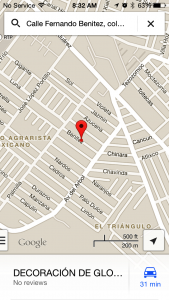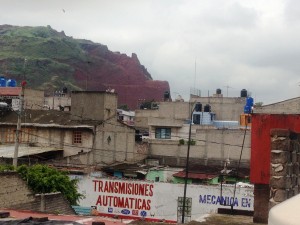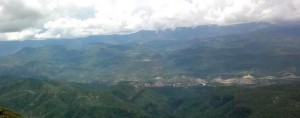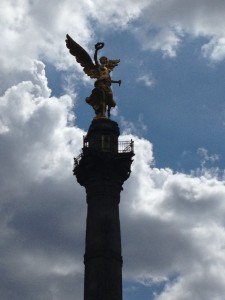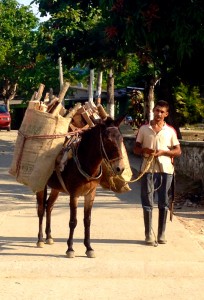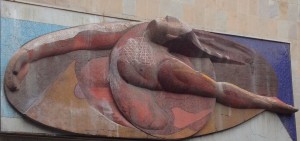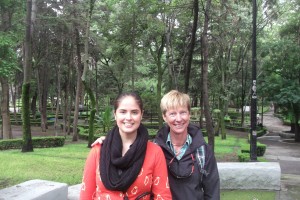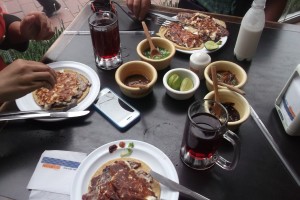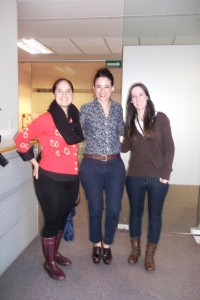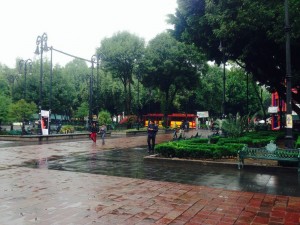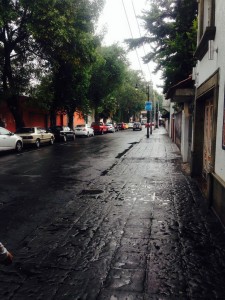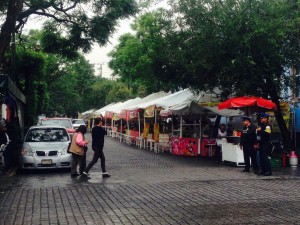Archive for category Mexico
Iztapalapa, the district hit by water conflicts.
Posted by Ainhoa Martinez in Ainhoa Martinez, Mexico on July 7, 2014
Our second individual interview took place this weekend, in the Delegation of Iztapalapa where we got a glimpse of water issues affecting an entire district.
This district lies in the northwest region of the city. An area high in crime, low resources and known to be overpopulated. Taking these facts into account, we decided to get to the district on Sunday because it’s a sort of family day, in which you can see streets full of parents with their children and local markets.
Getting to Iztapalapa was an adventure: the metro line we thought we could take all the way down to our destination was blocked off halfway. From what we were told, glitches in the line had made the rest of the line unsafe to travel. We took stairs back up to the street where a free bus line stopped at every closed metro station. After that we took a small van crammed with locals deep into the heart of Iztapalapa.
We couldn’t avoid thinking of Phoenix’s blog post about travelling in small buses in Ethiopia. The situation was funny and a little bit concerning, as we weren’t sure how safe the vehicle was. Fortunately, having women and kids around made us feel safe (this feeling has come to us in more than one ocassion). Over bumps and zig-zagging our way through what seemed like a maze, the van got us quickly to our destination.
We felt grateful that our interviewee opened her home to us with open arms. We explained the project once again and asked if we could videotape her story, “anything to help bring attention to this,” she replied, nodding in agreement. She gave us the history of her family and it’s issues with water scarcity and contamination. With a bright eyed, joyful demeanor she began to weave a story that started decades ago, when there were no water problems at home.
We were amazed to find how a little bit of clean water can be used time and again for different household chores. It made us conscious of how much water we use daily without once thinking about how we might recycle it. Water used for showering, to flush the toilet. Water used for washing clothes to mop floors. In this case we learned that need leads people to be creative in finding solutions to survive.
We left the house with the feeling of a job well done, and the hope that our project brings a voice to these problems. If we can help this family by telling their story we will have done our job.
On our way back home, almost by chance, we found multiple “Pipas” (trucks used to distribute water to individual houses). We quickly took our cameras out and took photos for about 20 seconds, until we saw a guard approaching us and we quickly left.
Weeks before, a policeman started asking questions about “what we were doing” when on Insurgentes taking a photo of a road that was flooding. “It’s for the photo memory album, we are from a small village and have never seen so much traffic in the street,” we lied. Then the policeman started talking about the World Cup and we quickly slid away. So this time in Iztapalapa, we didn’t want to try our luck!
Re-discovering the meaning of water in the land I thought I knew so well.
Posted by Jessica Sanchez in Jessica Sanchez, Mexico on July 4, 2014
I’m halfway through my journey as a Peacebuilder in Mexico, and every week I’ve come to re-discover the land I thought I knew. It’s one thing to be a native of Mexico, it’s another to be a foreigner in Mexico, and still another to see Mexico and the U.S. as “home,” even when I feel like a native of and a foreigner in, both.
Let me explain.
The phrase designated to identify me by census questionnaires, law school applications, insurance agents and many other U.S. institutions is “Mexican-American.” “Mexican-American,” has always seemed to me to be a superficial oversimplification of how a person born in the U.S. might identify themselves. It’s hard enough for a person to find an identity, but doing so under this classification only multiplies the obstacles. Needless to say, I grew up confused about my place in school and U.S. society in general, not to mention how school and society saw me. In my journey to find an identity, all that was clear was that I was never just considered “American,” hence I never just felt “American,” though I was born, raised and educated in the U.S.
Crossing the border didn’t make my understanding any clearer. My parents are from a small village, Villa Guerrero, in Jalisco, Mexico, a place I’ve visited for different lengths of time just about every year since I was a child. A place filled with family, friends and memories. I was raised on Mexican traditions and culture, I speak fluent Spanish (by that I mean that people in D.F. often don’t even realize I wasn’t born in Mexico), I’m very invested in the political, social and economic progress of the country, and do in fact also call Mexico “home”. Yet, natives identify me as a “gringa.”
Today I have much to learn about myself and my identity, and though I do not call myself “Mexican-American,” I live happy and passionately as a hybrid. My dual identity provides me the ability to understand, adapt and belong to two very different countries. It facilitates my ability see things natives and foreigners of each country may not understand. As a Peacebuilder, however, I have come to see things that had escaped me; that natives and foreigners might see and understand more easily because of their long or short standing relationship with the country.
What do I mean by this? Water.
It’s not until I became a Peacebuilder that I began to see the role that water played in the village I’d known all my life. Water had surrounded me in one way or another since I was kid and now I realize I’ve known about water in Mexico for a very long time. My father and his family own ranches in Jalisco. Often he’d take me along for a ride to see the cattle, the lands, the horses, instilling in me the importance of water in keeping them healthy. He’d show me the river that nourished his crops and divided his land from others; the niches dug out to drain water and guide it to where it was most needed; the wells that collected the water supplied to the land; the water holes that kept the cattle hydrated; and the lake that provided water to the village’s inhabitants. Every visit, water was a topic of conversation and there was never enough of it.
Until this point I’d never much paid attention to the issue of water in Villa. I’d never felt its scarcity. I’d always had it when I needed it. That tends to be the norm though, doesn’t it? An issue often doesn’t come alive for someone, until they’re affected by it in one way or another. In the case of water, most people don’t worry about until they don’t have it. Now I see it, care about it, and attempt to do my part to conserve it. I feel guilty for my lack of awareness all this time.
This week I asked my mother about water in Villa, something I’d never done before. She responded, “it’s rained a lot lately” and that because of it Villa was beautiful. Now I understand this simple response in a new light. Villa is beautiful because it’s not suffering from a lack of water: it’s inhabitants have enough to drink and use for daily chores, the animals it breeds and maintains to survive are healthy because they’re hydrated, and because the soil is nourished it’s crops may flourish. Now I realize that when the answer is, “there is little water, it hasn’t rained,” the reality will be far more complicated.
VARIATIONS ON A THEME
Today, America celebrates the adoption of its Declaration of Independence, marking 238 years of freedom from British rule.
On the 14th of July, Bastille Day, France will honor the battle which lead to the end of feudalism and the enactment of its Declaration of Rights of Man and of the Citizen.
As I walk around Mexico City, I am surrounded by monuments built in memory of this country’s myriad battles for independence, and to honor those who have continuously fought for it.
Like Phoenix’ burro in the marketplace, these testimonies to human struggle unceremoniously plowed into me today, forcing me to take a moment to reflect that almost every corner of our world seems to have been in a war for freedom from one form of tyranny or another. (One doesn’t need to tweet, twitter, chirp, or be linked-in to know that there are vicious battles for freedom being fought, even as we sip and dip, here in our blog cafe.)
Whether as instigator of these fights for freedom, or the tool used to quell them, the denial of access to resources required to meet even the most basic of human needs becomes a common battleground. Deprivation of basic needs is spotlighted, at times, but too often hidden behind layers of obfuscation, sometimes self-imposed. (I plead the Fifth!)
As I listen, learn and relate the tales surrounding water–the lifeblood of all living things–I wonder if there could be a day when the world’s citizens join arms around the pozo (well) to guard it from exploitation and usurpation by they who would be king(s).
Just try to imagine the size of THAT monument to independencia!
The altitude of Mexico City
Posted by Ainhoa Martinez in Ainhoa Martinez, Mexico on July 2, 2014
These last days I have been feeling a little bit sick because of the lack of oxigen in the air and the altitude at which is located Mexico City. After calling my insurance service and visiting the doctor, I am feeling much more better now that I have taken the proper medicines.
The problem is that I usually live in a city located at the sea level and Mexico City is about 2,300 meters (7,500 ft) above that level. The higher the city is located, the less pressure is in the atmosphere. Because of that, there is less oxigen in the air and each person reacts in a different way. For example Amy came from Colorado, which is located in a higher altitude from the sea level than Mexico City, so she is doing well.

Mexico City is located in the Valley of Mexico, in the central-southern area of the country. In addition, there are 2 volcanos close to the city.
But what is most characteristic of this area is the fact that inside the city you can go from zero level (sea level) to the highest:

In this map you can see the different “Delegaciones” of Mexico city and their altitude above the sea level. “Delegaciones” are the different districts among the city.
And I wouldn’t be telling you all these facts if it had nothing to do with water conflicts. The altitude of the whole city and the different altitudes where the “Delegaciones” are located do affect the water problems of the city. It is all about water pressure. If the “Delegación” is located in a medium level where water reaches without the need of machinery, you will probably have no problem with water supply. However, if it is located in a higher level machinery will have to push it to the top, which generates a huge cost and does not always work properly.
For example, Jessica, Amy and I are living in “Delegación Coyoacán”. Inside Coyoacán there are different levels and as a result of that, you can find great water conflicts or the best water supply at the same time in the same area. If you had read Jessica’s last post on the blog, you will note she’s been having some problems with water at home, whereas I have no water supply problems at home because there is a lot of pressure in the water that enables it to reach homes.
Last day we were visiting the craft market of Coyoacán and had the opportunity to talk to the people working there.  We met Mrs. Mónica Robles there, a woman who was selling incense, natural products and tiny zen gardens at her market stall and who, for our surprise, was majored in Antropology. She told us people living in “Colonia El Rosedal” (a neighborhood just next to us in Coyoacán) were having some water problems.
We met Mrs. Mónica Robles there, a woman who was selling incense, natural products and tiny zen gardens at her market stall and who, for our surprise, was majored in Antropology. She told us people living in “Colonia El Rosedal” (a neighborhood just next to us in Coyoacán) were having some water problems.
We will plan to gather stories in El Rosedal area for the next week. Meanwhile, the Doctor told me to stay in bed and take my medicines for the next 3 days and Jessica and Amy are also looking after me (thanks Constructoras de paz!). I will be totally recovered for the weekend, when Jessica and I are visiting a house where the family members are suffering from water supply and sanitation problems. I cannot wait to see what we find there!
DOWN THE RABBIT HOLE
ARMS THAT AREN’T FOR HUGGING
HELPING HANDS THAT DON’T . . . or perhaps they do
(just not in the manner that I have so come to appreciate)
Words and their meanings
tumble
over
and
over
through space
as I try to get my bearings in this land of mind-altering juxtaposition.
It is the rare place, here, that I do not walk among armadas of men and their weaponry: on sidewalks, in train stations, crowding benches in drab colored rovers, caressing machine guns as they stand, walk and wait. The men with guns, it seems, never sleep.
On the opposite end of the gender spectrum, I have learned to attempt to blend into the pods of women clustered together in public places, so that they might go about their daily obligations without having to endure roving hands and suggestive glances. (In fact, Mujeres y Niños have designated spaces in trains and stations, evidenced by indelible signs, barricades, and guards that patrol the perimeters of these de-male-itarized zones.)
Paralleling, yet becoming too soon acclimated to existences that I could not have fathomed two days ago, I am enthralled by the rich art and history of this enchanting place, as well as by the sincerity and generosity of her people. They are passionate in their beliefs and commitments and more than willing to take time to share a story, a jugo, and help the Google-map challenged. The preparedness borne, apparently, of fear, fades into the backdrop of the daily tapestry of Life lived fully.
With a final juxtaposition for this day, I fortify myself for the fascinating work that lies ahead . . . . .
Welcoming a new Peacebuilder and my own problems with water.
Posted by Jessica Sanchez in Jessica Sanchez, Mexico on June 27, 2014
This week has proven an exciting and productive week. Amy Clark joined us from Colorado and we took a short trip down Avenida de los Insurgentes, a major avenue splitting D.F. into east and west. Overcast skies loomed above us, as cars zoomed by and we exchanged laughs about our experiences in arriving to D.F. We shared our first meal together of tasty rib tacos and salsas, green and red, to suit everyone’s palate. Though I’ve had plenty of tacos in my time here, it never seizes to amaze me how many different ways they can be prepared, tacos from Califa were delish. It felt like a meal with friends. Amy’s cheerful smile and vibrant personality quickly showed her to be a great addition to our little D.F. team. I’m very grateful to have her here for the next few weeks.
On another note, Ainhoa and I got to hear our first individual story on water issues. There’s more details about this encounter in Ainhoa’s blog, so I won’t repeat them, but I must share how phenomenal it felt to finally get to hear a real person’s experience about water issues in Mexico. All this time we’d been compiling organization contacts, using spreadsheets, sending emails, making phone calls; just for the chance to get to hear the real stories. Though it was short, it was worth it and now I feel like we’re on a roll. This one individual has connected us to another potential contact and we plan on meeting her soon. Thank goodness our work is paying off! Now that we’ve experienced our first story, I feel a bit more at ease.
Ironically, I had my own run-in with a water issue this very morning. I share an apartment in a large complex. On the bottom floor of by building is an elevator, two doors to exit the building in opposite directions, and a number of handwritten sheets of paper hung up to notify residents of bills that need to be paid or of upcoming events. I tend to ignore these notes because they usually don’t pertain to me. There was one particular note, however, that I failed to notice, but proved to be very relevant for me. On a white sheet, in big black marker was spelled out “homeowners, Friday, June 27th the cisterna will be washed, set water aside. Administration”. From what I’ve gathered, “cisternas” are tanks where water is stored to distribute either to a home or building. Since, our building’s cisterna is to be cleaned today, my roommates and I were suppose to set water aside. Unfortunately, it seems none of us took notice of it and I had just enough water to wash my face this morning! I came to Mexico to gather stories of the water issues residents face and I think today brought me a lot closer to understanding them, but also to appreciating how important water is in my daily life.
Our first water story after an exhausting day
Posted by Ainhoa Martinez in Ainhoa Martinez, Authors, Mexico on June 27, 2014
June 25th, we had a meeting with Mrs. Mara Hernandez (a specialist on water conflicts in Mexico).

Jessica and I spent half of the morning wondering around Insurgentes. It seemed like it had no end as it crosses the whole city from North to South.
Jessica and I felt a little bit lost among Insurgentes main avenue, Mrs. Hernandez was vague in giving us specifications about how to find her office, we might had the wrong address and Amy was in the city too, so we had to guide her in order to locate us among the huge avenue.
Surprisingly, Amy found the office and us in her first try to walk among the city alone. She is such an experienced woman with great skills and
I was impressed because I would not have been able to locate myself during my first day in the city without Jessica’s help. We were so happy to find her and got ready for our meeting.
The meeting went great and it was truly worth it. Mara helped us clarifying what kind of water problems are suffering people living in Mexico, she gave us different views about the conflict and provided us with some contacts which I am sure will be useful for us.
It was a wonderful coincidence that a woman working at Mrs. Hernandez’s office suffered from some water supply and shortages issues at her home and she felt comfortable in telling us her story. I felt glad we found our first story, but also concerned about this woman´s reality. Without water there is no life (in any extent, society level or location) and being able to empathize with people directly affected by water conflicts has given me a more human and real perspective out from the one I can take from the books or documentaries.
Coming back home was an adventure for us. We left Amy at the metro and Jessica and I took the metrobus, which is one of the fastest ways of travelling by public transport among Insurgentes avenue. Please check out my “pendeja face” while taking the metrobus, it was crowded and getting out of it could be described as giving birth to a crowd.
HOLY GUACAMOLE!
We aren’t in Kansas any more, Toto! Beamed at less than warp speed from the safety of my rocking chair—courtesy of United Airlines and some major “we’ve got problems, Houston” weather–I find myself immersed in a vibrant city that never seems to sleep. Bienvenido a Mexico City!
Swathed in the mantle of uncertainty and fear donned with my backpack in Boulder, I scuttled into a hermit shell at 1:40 this morning, vowing to spend the next three weeks studying my Spanish for Niños in a hovel, hoping that people might drop in, wanting to share their stories with me, en ingles perfecto.

Summoning enough courage to venture forth a few hours later, I was amused and relieved to run into Phoenix’ friend, Serendipity. (That girl gets around!) Though the folks here haven’t exactly been throwing themselves at my feet to school me on “problemas del agua,” I found that a little small talk (I mean REALLY small talk) invariably lead to discussions about my interest in water and its confluence with “civilization.”
A little jugo de cactus . . . a dash of malodorous workout sweat, and the wheels are greased: my new acquaintances are more than willing to share their stories about water: Small talk reveals some BIG recurring structural themes: water quantity/sourcing, quality, allocation and the political and economic forces which play major roles in the ultimate stratification and deprivation. The nasty word del dia: “Privatization!”
But enough of this small talk! I am looking forward to giving you something other than the Cliff Notes version soon. For now, a note of gratitude to my fellow fellows, without whom today would have turned out to be much less productive and far less entertaining for one who has truly fallen off her rocker. Saludos, amigas!
Coyoacan
Posted by Jessica Sanchez in Jessica Sanchez, Mexico on June 24, 2014
One of my favorite places in D.F. is in Coyoacan, a delegation Northeast of UNAM, approximately 10 minutes by trolebus, from my apartment. At its center, a plaza bursts with vibrant colors. Restaurants, bars, and small shops form two large squares, divided down the middle by a small avenue. Inside these squares, benches, trees and lush shrubs decorate the plaza. On a rainy day like today, water fills the pores on the stone grounds. The wet soil smells of comfort and the surrounding greenery is rich with life.
This place, so different from anything in the US, feels like home. Walking the streets of Coyoacan I see beautifully decorated buildings, each adjacent to the next, an endless array of tones, personality and design. Uniform and disorderly, in their natural state.
At the Coyoacan Market, there are rows and rows of small posts, selling everything from candy, to flowers, to fruit, to toys, meat, and meals ready to eat. At every turn someone pops out of their post to greet you with a smile and ask if there’s anything you’re interested in. There’s a welcoming buzz in the background, of people shopping, locals selling, laughter, and gossip.
Here, I stop by my favorite fruit stand, where the owners know my face and my order almost by heart. The fruit here is sweeter than anything I’ve ever had in the US. My recommendation: Banana, strawberries, guava, figs, papaya, mango, all diced up and topped with honey and granola. I always order just one more thing: 1 liter of fresh squeezed grapefruit juice, with just a bit of orange juice for sweetness. It’s heaven and since I arrived in Mexico, Coyoacan has formed an integral part of my routine and the tasty fruit, a daily part of my diet.

